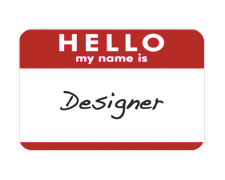 An open letter to the next generation of designers, part 1.
An open letter to the next generation of designers, part 1.Everyone has moments in their career when they look back and think, "If I had only known then what I know now...." After 15-plus years as a designer and design researcher at places like IBM, Trilogy, M3 Design, and now frog design, I know I certainly have. Which is why, now that I'm a veteran, I'd like to give share some advice with young designers just starting out. If I could be your mentor, this is what I would tell you:
1. Get the book
We all have a book that grabbed us by the throat and never let go, forever changing how we look at our profession. For me, that book was Sparks of Genius, The Thirteen Thinking Tools of the World's Most Creative People. The design process is, ultimately, the ability to creatively solve problems-and in our profession, we need to be better at it than most.
2. Get the obscure book you've never heard of
While it's an older book, The All New Universal Traveler – A soft-systems guide to creativity, problem solving and the process of reaching goals is still juicy today. It was written by architecture professors from California Polytech and the School of Architecture and Environmental Design, and presents a ton of research condensed into a tightly packed form.
3. Choose a topic that fascinates you and learn it inside out
This is how you become an expert. Your topic might be as broad as sustainability, or as narrow as a specific method like body storming. Over the last 10 years, I took on three provocative topics-emotional design, design research, and participatory design-and I just recently look on another: synesthesia.
4. Write, blog, and speak on that topic
You're an expert once you feel comfortable calling yourself an expert. Take Jakob Nielsen, who began blogging about usability back in the late 1990s. He became recognized as the source on usability because he was consistently churning out information on the topic. Were there other experts on usability? Sure. But Nielsen developed the early point of view, and wrote provocatively about the subject.
5. Learn Something New Every Day
Every designer should be on a quest to see the world with fresh eyes every day. This might be learning something-a bit of trivia, perhaps-that helps you see the world a little differently. For example, today I learned that cats can't taste sugar. This may sound trivial, but it could lead to a whole host of ideas. And so could the fact that they have hooks on their tongue to lap up water.
6. Create a New Idea Every Day
At one point I was twittering a new idea every day. (Example: "Product Idea #1: Skin Pens > did you ever write notes on your hand? i still do. i want a pen for skin writing on the go.") Now I file them manually. People will say that ideas are a dime a dozen, but I think they're wrong: I think the first 10 might be worth a dime, but the last two could be worth their weight in gold. I would suggest that the designer without an idea isn't a designer. Record them, capture them, and go back to them.
7. Experiment
Good designers experiment. One of my favorite examples is from fellow frog Michael McDaniel, who conceived of portable housing after Hurricane Katrina. When he didn't get immediate interest from government agencies, he built a full prototype in his backyard. I've experimented with measuring emotion through sound, and a scent alphabet, to name a few. When you do experiment, push the edges.
8. Learn as many frameworks as you can
In 2008, a design team at M3 (where I was working at the time) went through 400 design research methods, reduced the redundancy, and then sorted the remaining 250. This exercise, while daunting, was incredible: For the first time, a designer could see the research methods, or "frameworks," that existed in the design space. The point is, you should get comfortable moving beyond just brainstorming and start structuring data in such a way that it drives insight and innovation. When you get comfortable with many frameworks, you'll start creating your own. The only caveat is not to rely on them, because not everything can be modeled in a framework that already exists.
9. Choose variety over anything else
I turned down an offer that paid more to come work at frog. I've never regretted that decision. If anything, frog has made me crave variety in such a way that I doubt I'll ever be able to commit to just one industry. I've done everything from cell phone interaction design to social networking strategy, and from the future of electric vehicles to emotional medical identification. I would recommend to anyone that when you stop learning, it's time to move on.
10. Model or draw (all the time!)
To be good at anything, you need to do it a lot. And to be really, really good, you need to do it all the time. I don't care how great an idea is, if you can't model it, prototype it, or draw it, then you're screwed. If you learn nothing else from this blog post, please find a way to learn how to make your ideas tangible. This can be through graphic design, sketching and rendering in Alias, a flash prototype, photography, video, whatever. Just learn the tools of the tangible.
This is just the first part of Laura Richardson's article the second part will be coming in a day or two so check back! As always if you need any design ideas or work done please give us a call at K-Squared Designs 270-761-5237 or visit us at www.k-squareddesigns.com.


No comments:
Post a Comment